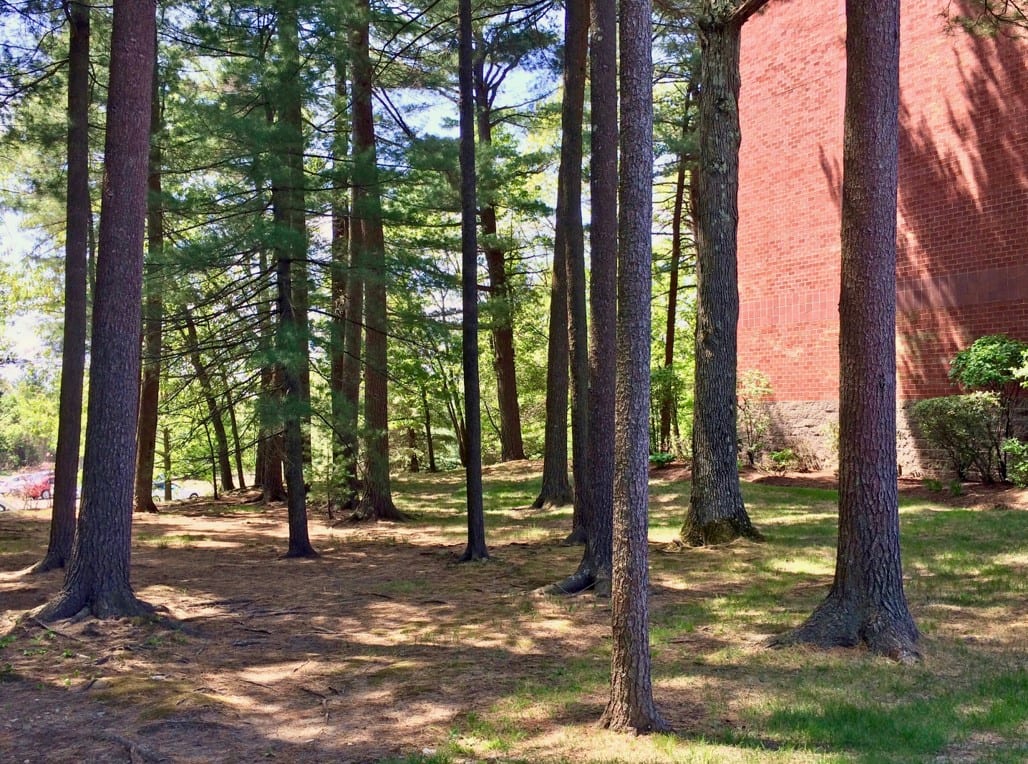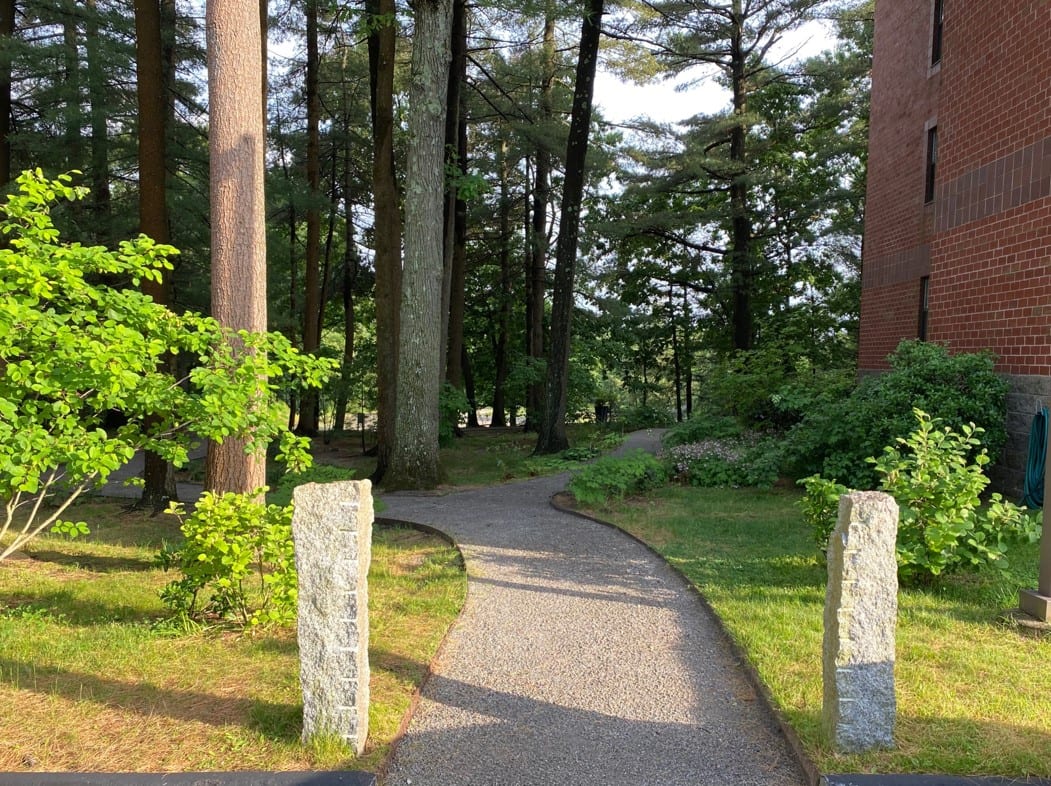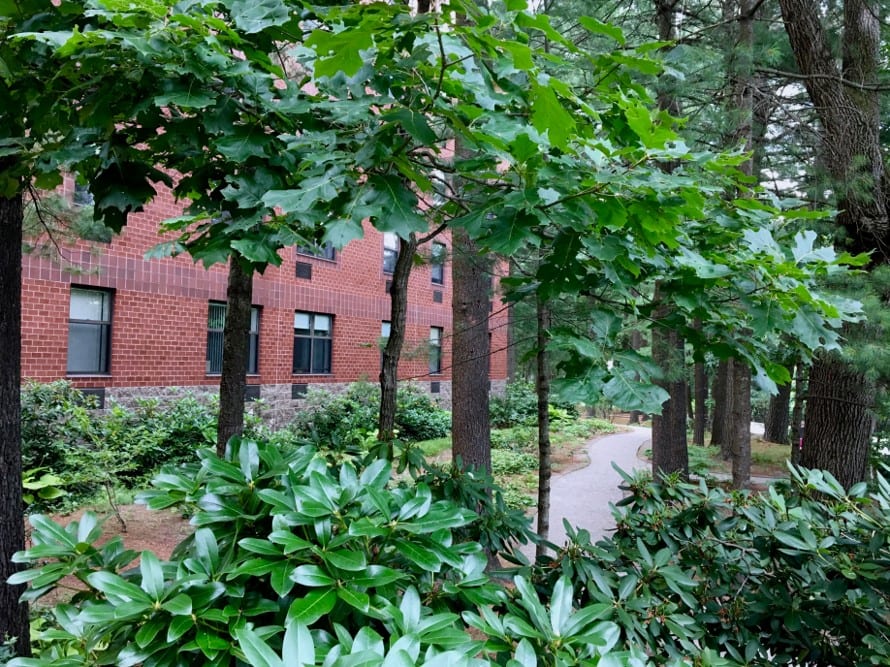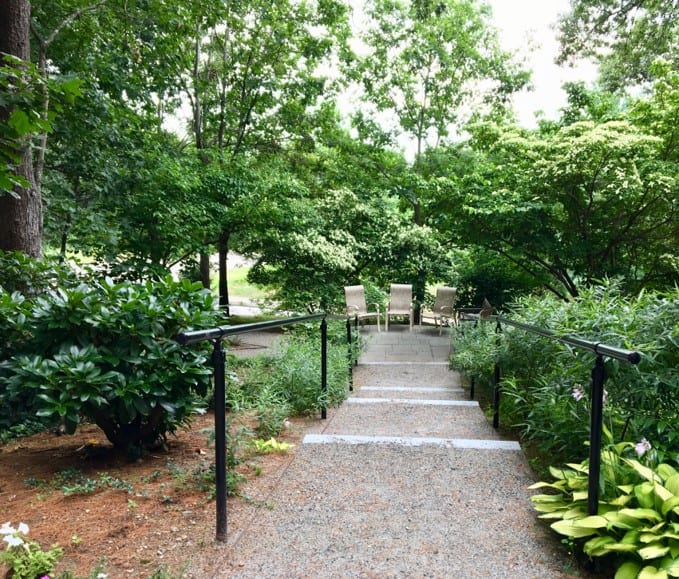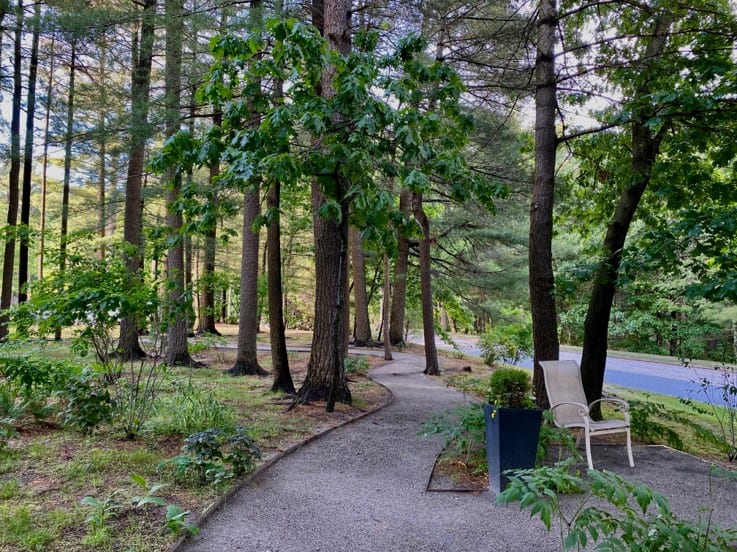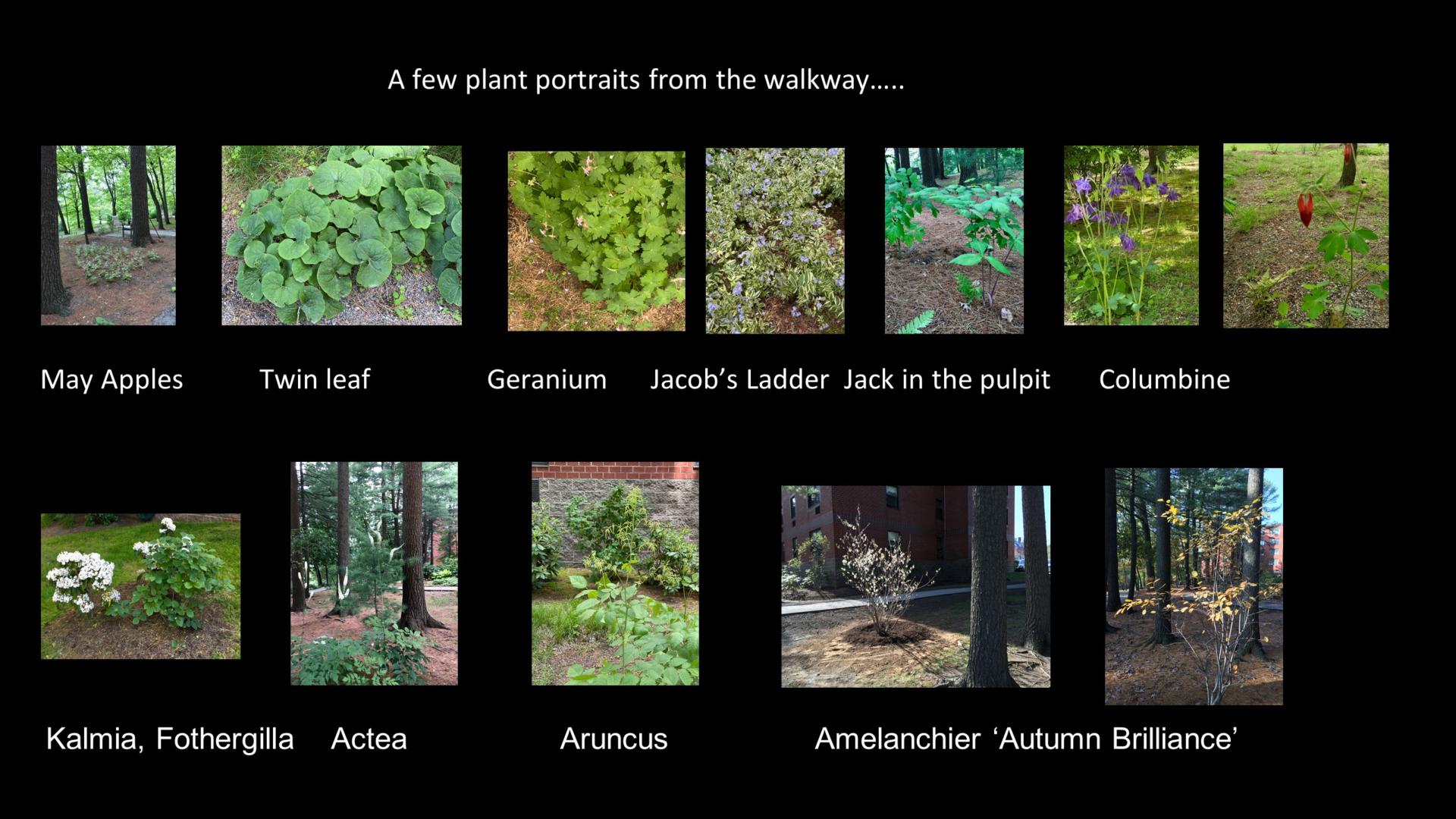Hosted by Sally Muspratt
I was first invited to Coleman House to plant the parking lot islands but became entranced by the possibilities of the adjacent unused pine woods. In 2015 I developed a concept plan creating a woodland walking loop connecting the parking area to a Memorial Garden on the opposite side of the building. I included two small sitting areas for quiet enjoyment and one larger circle for conversation. The peaceful green woodland walk links the bright annual plantings of the parking lot and Memorial Garden with the contrasting experience of an enhanced natural woodland and provides the elderly residents an opportunity for safe, gentle exercise in the open air. The enthusiastic manager let us install the garden in 2016. Parterre Design installed the steps, the circular terrace, and the stone dust paths, carefully avoiding damaging the roots of the all-important tall pines.
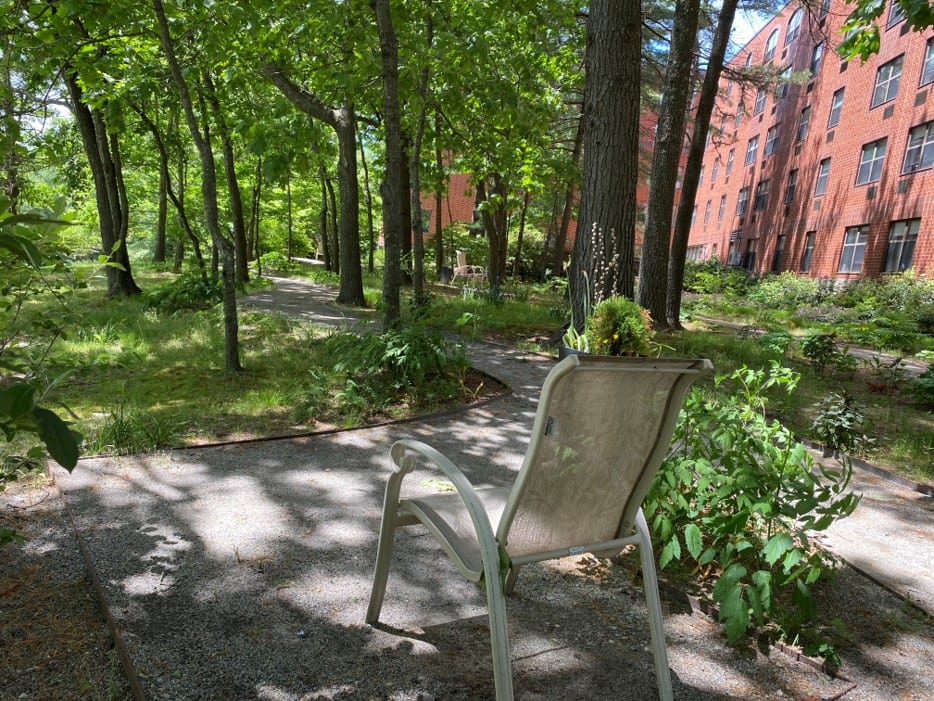
The woodland walk at Coleman House, a residence of 2 Life Communities, 333 Nahanton Street, in Newton.
Besides the pines, the pre-existing plantings were mature Kousa dogwoods near the Memorial garden and rhododendron and hosta at the foundation of the building. Irrigation already in place enabled much lusher growth for our plantings in this area than on the windy hillside. We added an understory of trees and shrubs to screen the approach drive and the parking lot and to create a sense of a separate, enclosed space. We improved the soil and gradually added native trees: birches, Amelanchier and additional pines— and shrubs: Hamamelis (witch hazel), spring and fall flowering; Fothergilla, Aronia, Aruncus, Viburnum (both acerfolium and dentatum) and mountain laurel and blueberries, which prove irresistible to deer, but continue to survive. The Amelanchier is the greatest success; the birches and oak-leaved hydrangeas sadly did not survive, despite supplemental watering. The border of sweet fern, (Comptonia peregrina) leading up the sunny steps to the Memorial Garden has grown to a scented, bushy four feet.
We planted inexpensive bareroot plants and plugs of Christmas ferns and wildflowers, including American lily of the valley (Convallaria majalis), Tiarella cordifolia, Jeffersonia (twin leaf), foam flower, Canadian ginger and columbine, mayapples, Jacob’s ladder, Jack in the pulpit, Solomon’s seal, and Pennsylvania sedge. The two most flourishing perennials are Actea racemosa, which grew in five years from tiny plugs to impressive, shrub-sized accents by the path, and Geranium macrorrhizum, ‘Bevan’s Variety’, which has spread into wonderful masses with a year-round presence. The ‘Stairway to Heaven’ Jacob’s Ladder has also done well; I regret choosing it only because its variegated leaves do not contrast well with the geranium when it is in bloom. The only non-native plantings we added are narcissus, snowdrops, and scilla for early spring color.
With the help of the Coleman House ground superintendent, who keeps the paths tidy and helps with watering during droughts, my group does the routine maintenance in the garden. We add leaf mulch to the plantings annually, deadhead, and do minimal weeding. We all love working in the garden; the pleasure the residents take in this peaceful space is a joy to us all. This month, when the seats were replaced in the garden at 6’ apart, we rejoice at the return of the people we intend the garden to delight.
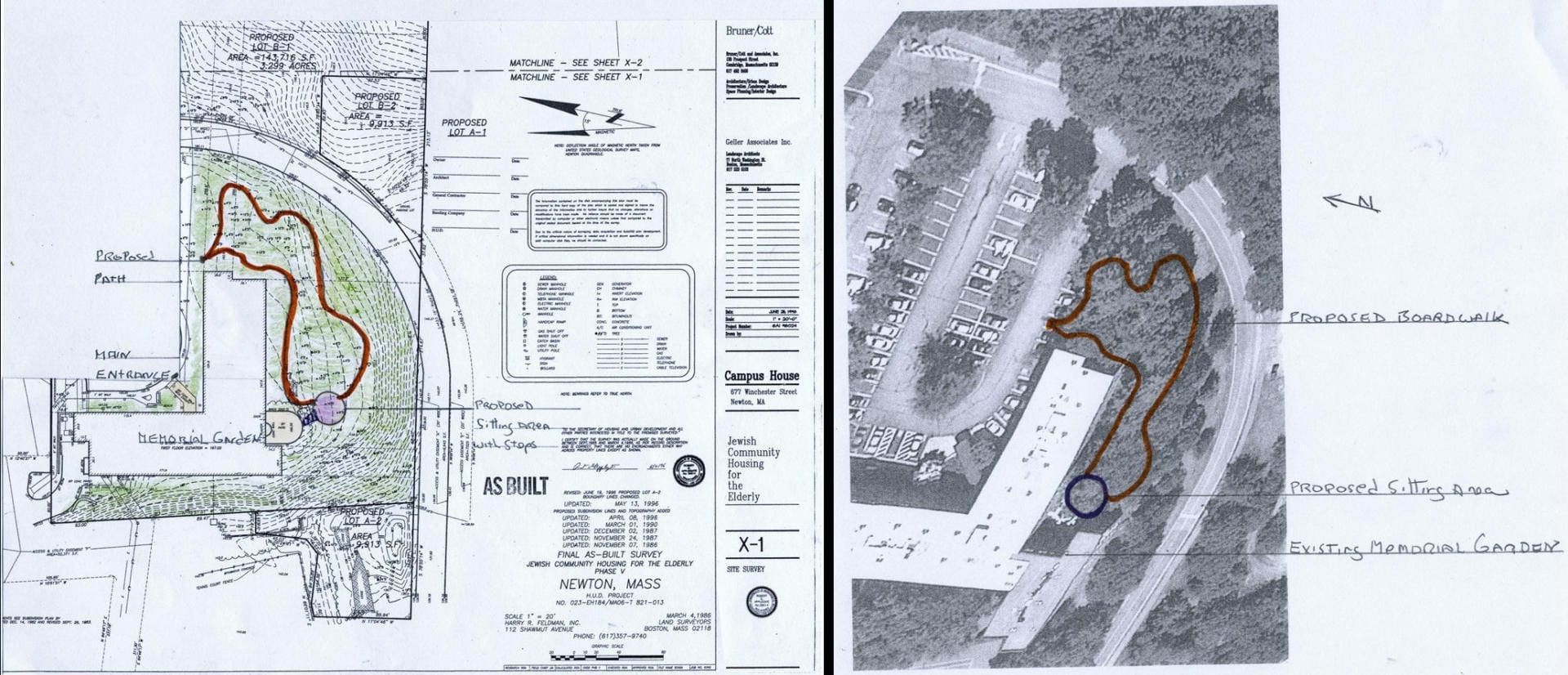
I proposed a circular walkway winding through the existing trees and connecting the parking lot with the Memorial Garden.
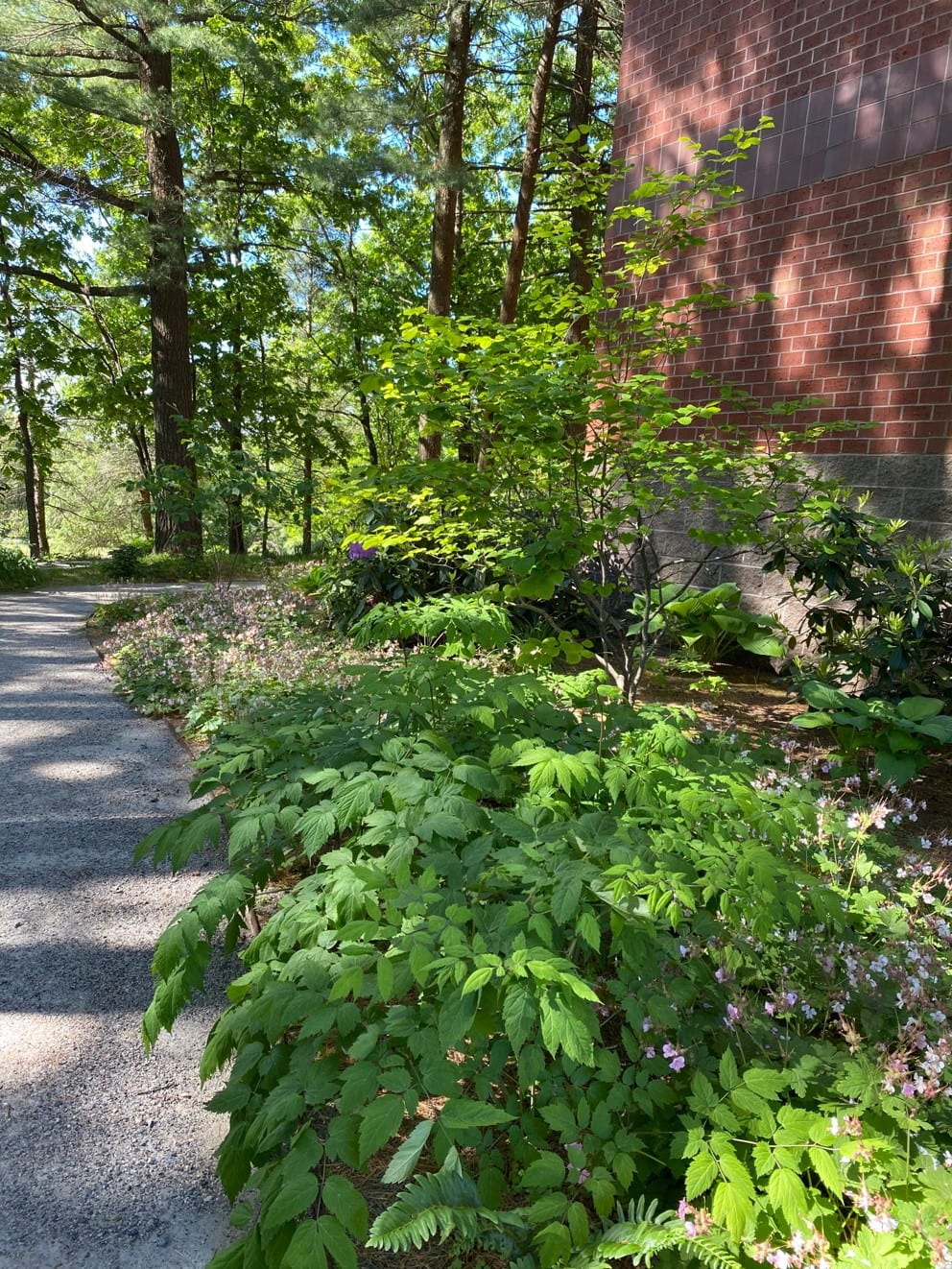
Proceeding counterclockwise around the building, one sees the lush spring growth of Actea and Hamamelis and the bloom of geranium and Jacob’s ladder.
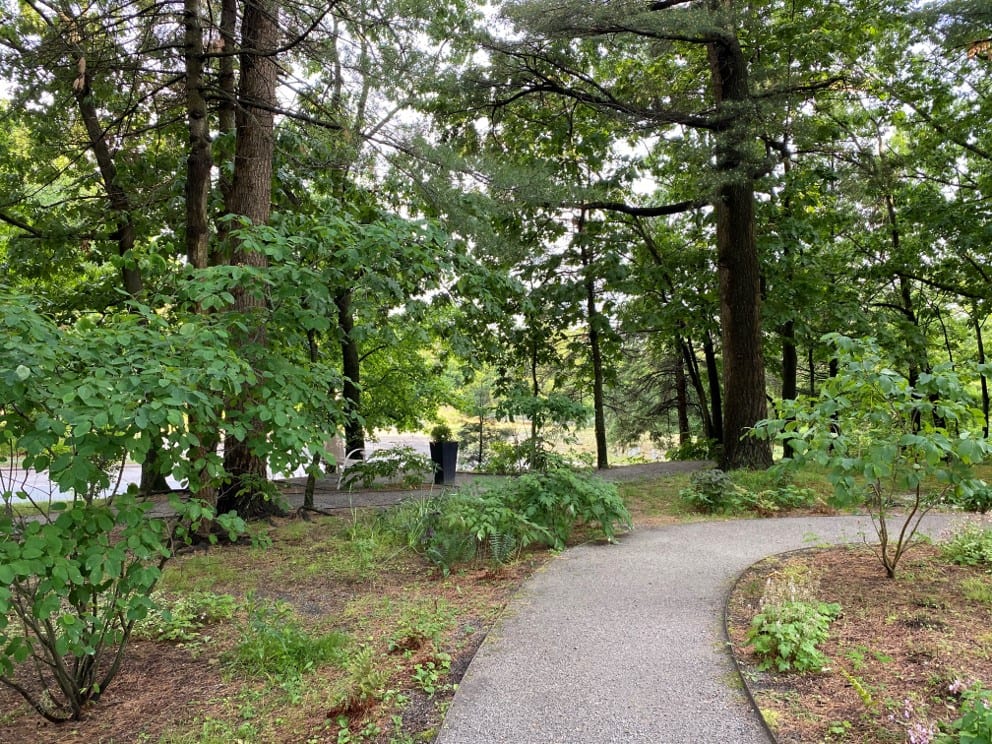
The first curve in the path is marked by Amelanchier and a mass of Actea on the left, and a Hamamelis on the right. One of the two sitting areas is visible across the mossy central area.
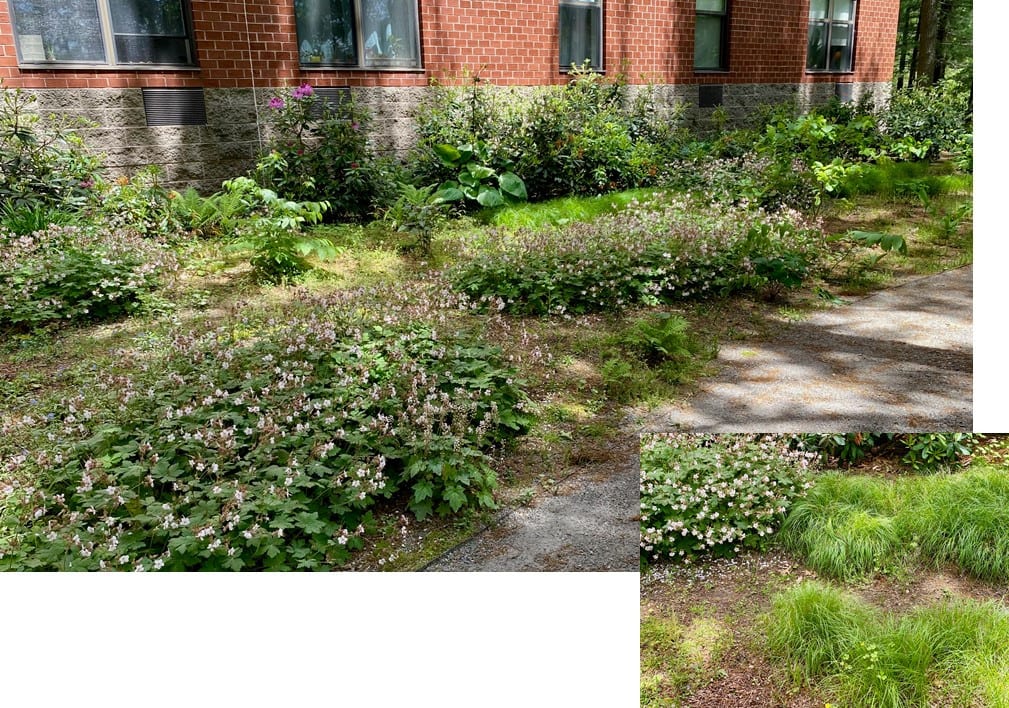
Rounding the corner on the right one sees a mass of Carex pensylvania and three lush plantings of geranium ‘Bevan’s Choice.’ The path is edged with ferns and American lily of the valley.
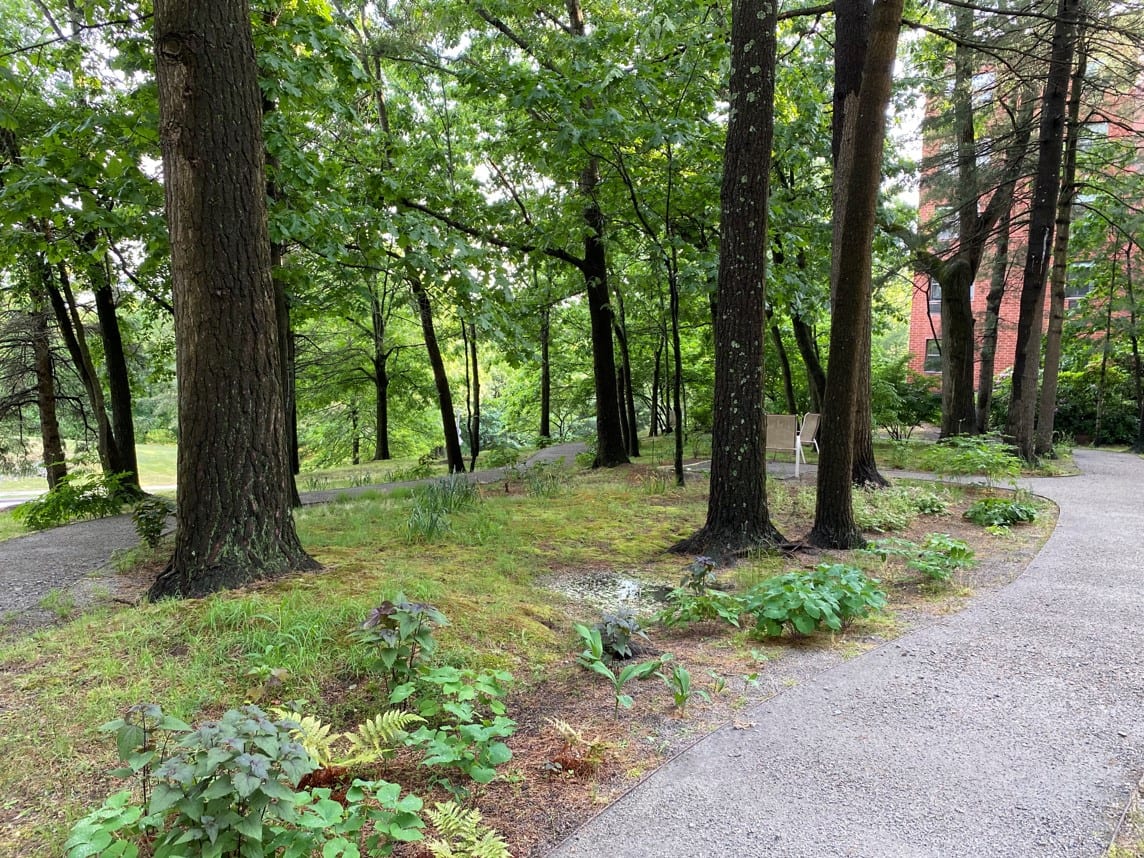
Opposite is a border of ferns, twin leaf, tiarella, and eupatorium, which is less attractive to the deer and rabbits than the asters we tried first. The existing moss is welcome.

The path ends at the gathering space set beneath the preexisting Kousa dogwoods. Before social distancing for the coronavirus, chatting residents filled benches in this sunny space. It floods only after downpours! The stairway is at the right.
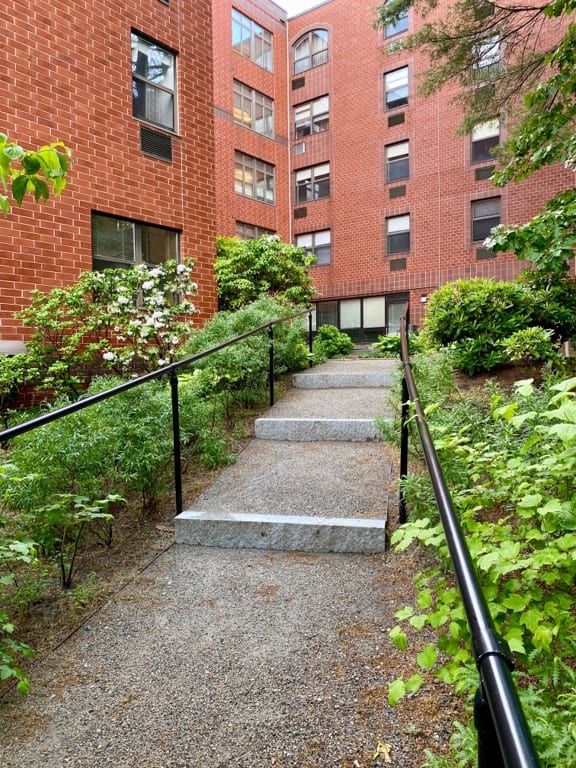
The ramp/stairway to the Memorial Garden entrance/destination of the walk is edged with thick borders of scented Comptonia.
I hope soon you will be able to visit the garden in person!
About our Host
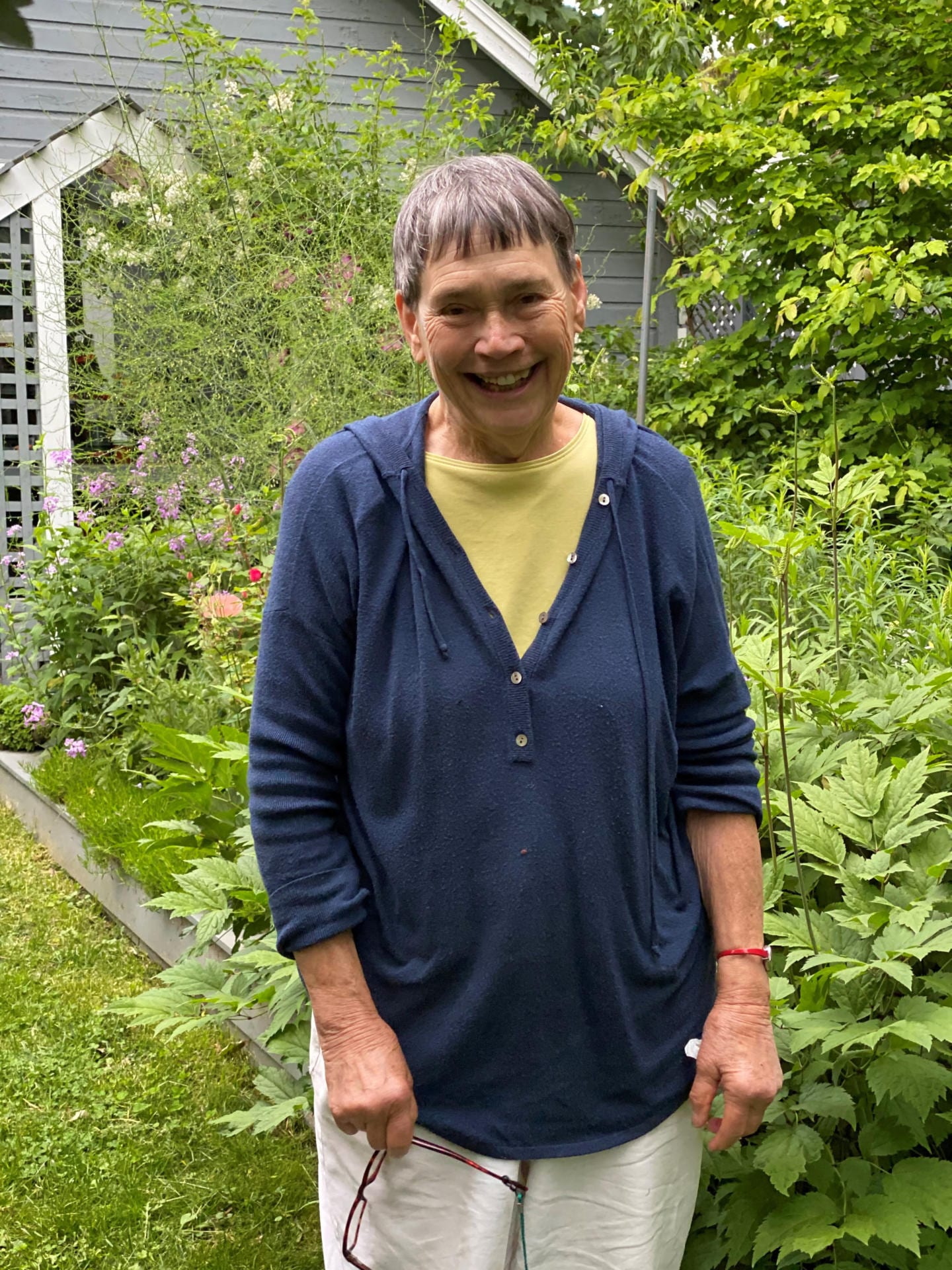 Sally Muspratt is a graduate of the Radcliffe Landscape Design Program and is accredited by the Association of Landscape Designers and NOFA. She consults on civic plantings, lectures and writes, and designs public and private gardens. More information is on her website, www.smmgardens.com.
Sally Muspratt is a graduate of the Radcliffe Landscape Design Program and is accredited by the Association of Landscape Designers and NOFA. She consults on civic plantings, lectures and writes, and designs public and private gardens. More information is on her website, www.smmgardens.com.
***
Each author appearing herein retains original copyright. Right to reproduce or disseminate all material herein, including to Columbia University Library’s CAUSEWAY Project, is otherwise reserved by ELA. Please contact ELA for permission to reprint.
Mention of products is not intended to constitute endorsement. Opinions expressed in this newsletter article do not necessarily represent those of ELA’s directors, staff, or members.

